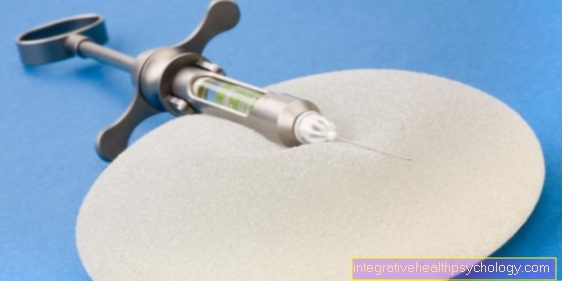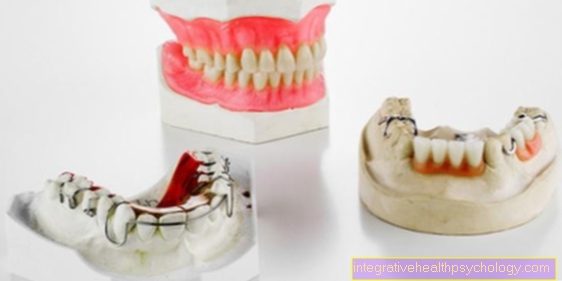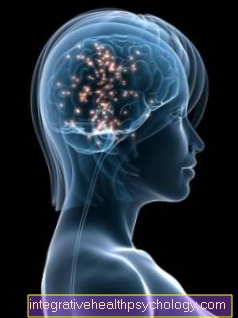Side effects of local anesthesia
General side effects
Overall, regional anesthesia / local anesthesia are considered very safe with few side effects, since usually no systemic reactions are caused.
However, if the anesthetic is accidentally injected into veins or arteries, this can lead to extreme circulatory problems, because the anesthetics also inhibit the transmission of nerve signals in the heart and brain.
What might also interest you: Complications in anesthesia

Such Intoxication (Poisoning) or side effects can be divided into different stages.
- The prodromal stage is through a perioral numbness (that runs around the mouth) and one metallic taste marked in the mouth.
- The preconvulsive stage leads to Tremble, one Tinnitus, nystagmus and somnolence.
- In the following phase, the convulsive stage, it becomes clear central reactions with tonic-clonic seizures.
- In the last phase there is a clear decompensation of the brain with coma, respiratory arrest and circulatory collapse.
In order to avoid this maximum complication at all costs, local anesthetics can first be given in small trial doses in difficult cases in order to confirm the correct position.
In addition, ultrasound or nerve stimulation should be used to secure the position. Since the patient is awake and responsive during the local anesthesia, careful attention should be paid to this. For example, if the patient specifies a strange feeling or metallic taste reacted in the mouth to avoid worse complications.
The most important measure in the event of such complications is to secure the vital functions. This includes oxygen and, if the brain is involved, intubation to secure the airways.
Cardiac arrhythmias
Local anesthetics work at the cellular level by blocking certain ion channels. As a result, they hinder the transmission of excitation from one cell to the next and thus also the transmission of the sensation of pain.
If too high a concentration of the local anesthetics gets into the circulatory system, this can also block the conduction of excitation in the heart and thus trigger sometimes life-threatening cardiac arrhythmias.
Since local anesthetics are mostly applied superficially to or near the spinal cord, this side effect is very rare.
Side effects on the cartilage
In addition to surgical procedures, local anesthetics are also used in pain therapy, for example after an arthroscopic procedure on the shoulder or knee. According to a study, there is a risk of damage to the hyaline cartilage, especially when using a pain pump, which continuously pumps pain medication into the joint.
In particular the local anesthetic Bupivacaine leads to the dissolution of the cartilage (Chondrolysis). This can lead to symptoms such as joint pain, restricted mobility and stiffness of the joints.
Which might also interest you: Cartilage damage
Local anesthesia in dentistry
Many dental procedures are painful. Therefore, the dentist recommends the use of a local anesthetic in the form of a syringe if the pain is foreseeable. In general, local anesthesia is very well tolerated and only rarely leads to side effects.
The frequency of the occurrence of side effects in the context of local dental anesthesia is estimated at around 1: 1,000,000.
Find out more about the topic here: Dental pain elimination
What every patient knows: After a visit to the dentist, the anesthetized region usually remains numb for some time. Therefore caution should be exercised when eating and drinking afterwards. The numb lip does not feel if you accidentally bite it. This can lead to unnoticed injuries. Accordingly, you should only eat again when the feeling in the lip has returned. Otherwise, the physical reaction to the local anesthesia mainly depends on individual factors, for example the age of the patient, his comorbidities, or his general physical condition and allergies.
Local side effects that may occur are pain at the injection site or inflammation caused by pathogens that have settled through the puncture site in the gums. In the long run, this can develop into a painful abscess (accumulation of pus in the tissue), which often has to be opened surgically. Pain at the injection site is common but harmless. It disappears on its own within a short time.
Infection is very rare and usually affects people who have a significantly weakened immune system.
In the worst case, the doctor hits a nerve directly when the syringe is punctured. This is very uncomfortable for the patient and manifests itself in one stabbing, shooting pain.
This can lead to long-term numbness in the anesthetized area. However, these usually regress again. Only in very rare cases does the numbness persist. The syringe can also damage blood vessels running through the gums. As long as the patient does not suffer from a coagulation disorder, this is usually harmless, as the bleeding usually stops by itself after a short time. If blood clotting disorders occur, it may lead to heavy bleeding.
Of course, allergic reactions to the local anesthetic can also occur. These can be caused by slight local reactions (Redness, swelling, itching, rash) up to strong systemic reactions (anaphylactic shock) with shortness of breath, dizziness and cardiac arrest.
Cardiac arrhythmias can also occur. Local anesthetics that contain adrenaline can lead to further systemic effects. Adrenaline acts as a vasoconstrictor. This can potentially lead to an intoxication reaction in the circulatory system, which manifests itself in headaches, palpitations, rise in blood pressure, anxiety and hyperventilation. Ultimately, this can result in a loss of consciousness. This can occur in particular if too much of the local anesthetic gets into the circulation, for example in the case of undesired intravenous administration. However, this is very unlikely if the mouth area is anesthetized.
Read more on the topic: Local anesthesia at the dentist
Overall, the risk of side effects from local dental anesthesia is very low. If you have ever had an allergic reaction to local anesthesia or are known to have other drug allergies, you should inform your dentist beforehand.
Accidental nerve blocks
If a nerve block occurs during local anesthesia, this has no serious consequences. The nerve block is often caused by the local anesthetic being flushed around the nerve; the nerve itself is not damaged.
In most cases, the nerve block only leads to a greater spread of the anesthetic, possibly with motor failures, which, however, usually occur regress within a short time.
Side effects of tumescent local anesthesia
The special side effects of tumescent local anesthesia are primarily caused by the drugs used and the large volumes of local anesthetics. The high amounts of irrigation fluid that are injected during the procedure place additional stress on the body's circulation and can lead to a so-called Hypervolemia lead to an increase in the volume of blood circulating in the bloodstream. This does not lead to an increase in blood volume, but only to a thinning of the blood, since the supplied liquid also passes into the bloodstream, among other things.
This additional load on the blood circulation can be particularly beneficial for patients with previous cardiovascular diseases life threatening become.
Also a Pulmonary edema - Water in the lungs - can be a serious complication of hypervolaemia.
In addition, there may be a systemic toxicity of the local anesthetic used or a systemic reaction to adrenaline with consequence of severe cardiac arrhythmias.
Recommendations from our editorial team
- Peripheral nerve block / femoral catheter
- Spinal anesthesia
- Epidural anesthesia
- general anesthetic
- Local anesthetics - The local anesthetic
- Dental pain elimination
- Local anesthesia at the dentist





























